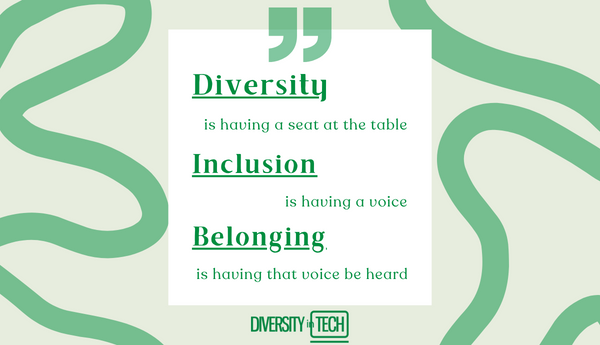Investing time and money into a diversity equity & inclusion strategy is hugely important for every business, big or small. It’s a hot topic for a reason; everyone should feel completely comfortable, valued and a sense of belonging at their workplace. Many employers talk about being inclusive but these words don’t transpond into actions. It’s commonly seen as a ‘tick box’ in the corporate world, but having a clear, educated and thoughtful DE&I programme is the key to a happy, innovative and profitable organisation. In this article, we look at the traits of a truly inclusive employer and how these can be implemented.
Diversity and inclusion are often grouped together, but it’s important to consider them as separate entities. Diversity is on the agenda for most company senior management teams, but sometimes inclusion fails to be paid as much attention. Diversity is about the people who make up the workforce of a company, whereas inclusion is the feeling of these employees. Inclusion is about embracing the diversity of your company, ensuring that all employees feel safe, secure & valued.

“Diversity is having a seat at the table, inclusion is having a voice, and belonging is having that voice be heard” – Liz Fosslien
So, what are the traits of an inclusive employer?
In a truly inclusive company, the commitment to diversity, equity and belonging should be clear from the first contact someone has with them. The recruitment and onboarding phase is a common place where employers can fall down in their DE&I strategies, as there are so many points to consider here. When looking at implementing an inclusive recruitment strategy, the following points should be considered:
The first step in recruiting is usually defining the role which you’re hiring for. If you’re an in-house recruiter this doesn’t always sit with you personally and may be the responsibility of another team/the hiring manager. However, it’s important that diversity & inclusion is considered here. You need to ensure that the role requirements are clear, concise and kept to the absolute essentials. The more requirements you add to a job advert, the less likely minorities are likely to apply, for example women have been found to only apply for jobs if they meet 100% of the requirements.
When compiling a job advert for the role you’re advertising for, it’s important to ensure that it’s accessible / can be made accessible for people with disabilities or impairments. There are software options to help with this. A common downfall of job adverts is using gender-coded or biased language, and failing to mention inclusive benefits and schemes such as flexible working and menopause support for example. You should also include salary as standard on all job adverts to be transparent and upfront about what the role will be paid.
When you source your candidates, consider where you are advertising. Are there any niche/specialist job boards you could post the job on? Could you hire from programmes aimed at helping people get into technology? It’s also important to ensure you gather any special requirements people may need for the interview process should they be chosen. Ensure you can make any adjustments to help make the process smoother for candidates.
Another important step here is to practise anonymising candidate profiles so as to reduce recruitment bias. Things like blind hiring can help here, removing any identifying attributes at shortlisting stages so hiring managers aren’t prone to unconscious (or conscious!) biases.
When interviewing candidates, think about the panel you’re using for the interview and consider if it is a diverse representation of the team. If the hiring managers are all one gender/race for example, consider asking another employee to sit in too. It doesn’t matter if they’re not part of the team, but it may make someone feel more at ease in the interview. It’s also good practice to inform candidates of the interview structure ahead of time where possible to reduce anxiety. Ensure the interview is accessible and flexible where needed. For example, a candidate might require an interview time which is slightly out of office hours, try to accommodate this where possible.

The best way to measure how your recruitment process is is to ask candidates who have been through it. Surveys can be a great way of collecting feedback and improving on practices to increase inclusivity. Make sure you ask both successful and unsuccessful candidates to ensure you get a full picture.
Onboarding is an essential step to ensure employees feel included and valued from day one of their employment. Ensure your onboarding process is carefully thought through and clear for the new starter; there’s nothing worse than feeling neglected in a new job. Provide lots of context about the role and involve the whole team to ensure the new member is welcomed and feels comfortable about the job they accepted.
A company is nothing without its employees, and so it’s arguably the most important aspect of being inclusive that your workforce feel happy and valued, as well as feeling comfortable to raise ideas and concerns. Often in larger companies, employees can feel more of a ‘number’ than an individual, and this contributes to a feeling of not being valued. Taking time to get to know your employees on an individual basis may seem time-consuming and perhaps overbearing, but it can do wonders for people feeling like they’re part of the company. Successful companies have a culture where people feel comfortable raising ideas about how to improve processes without being shot down, plus, this can benefit your company by saving time/streamlining too.
When employees feel that their voice is heard and respected, they will ultimately feel happier and safer in the workplace. Recognising employees’ hard work, whether through verbal praise or through rewards is also an important aspect of an inclusive environment. However, be careful not to only reward certain ‘favourite’ employees as this can lead to a sense of other colleagues feeling demotivated and unvalued.
Employees from diverse and minority backgrounds might find it difficult to fit in if they feel like they are on their own. Create a culture of inclusion by ensuring all colleagues respect everyone within the business. Stamp out any discrimination or bullying as soon as you know about it, as these situations will create unpleasant connotations. Consider starting employee resource groups or networks to support employees from diverse backgrounds and foster allyship.
Nurturing your employees to grow and be the best version of themselves is another aspect of inclusion. Focusing on individual growth and development through things like goals, mentorship & training courses will add to the sense of belonging and value we’ve just spoken about. Every employee should feel like they have a clear development plan (if they want one), and have the opportunity to better themselves, learn, ask questions and grow.
Providing these opportunities through things like training courses, mentorship schemes, work trips, learning exercises and more will show your employees that you care about their development and journey with the company. Colleagues will want to stay at the business and grow with it, rather than feeling neglected and leave.
Another important aspect of being an inclusive employer is ensuring everyone at your organisation can do the job they were hired to do without difficulty. People with disabilities or impairments might need specialised tools or arrangements to feel comfortable and confident. For example, someone with a hearing impairment may appreciate closed captions software in meetings (especially video calls). Or perhaps you’ve employed someone who feels socially anxious and might prefer to work from home or a quiet corner of the office. Supporting these individuals to make them as comfortable as possible is a key step in being an inclusive employer. With the right tools and environment, employees can thrive and be more productive.
Being an ally is defined by Inclusive Employers as someone who is not a member of a marginalised group but wants to support and take action to help others in that group. It’s important in everyday life, especially in the workplace. It’s about actively taking an interest and educating yourself in understanding the issues other people may face, and standing up/fighting for these issues when needed. 
Employers should foster a culture where being an ally is expected of all employees. By educating people about what it means to be an ally, more employees will listen and learn to take on board other people’s opinions. You will likely also see microaggressions and discriminations being called out.
Another side of allyship as an inclusive employer is to support and celebrate charities and events related to minority diverse groups. Running lunch & learn sessions for employees to join and learn about the background and struggles they face is a great way of supporting employees and creating more allies in your workplace. Diversity in Tech have a full calendar of diversity and inclusion awareness days & events for every employer to be aware of and mark.
Research has shown that candidates will actively look for employers who invest in and care about diversity, equity & inclusion when looking for a new job. A good DE&I strategy isn’t an easy fix, and will inevitably cost a business money and time. However, it’s an important factor to consider which will help with innovation, profit and employee retention. Some examples of things to invest in to be an inclusive employer include:
Finally, a large part of a truly inclusive culture is ensuring opportunities are equal for all, not just for some. It’s all well & good hitting diversity quotas and targets, but if the diverse employees are all in entry level positions and aren’t given the opportunities and tools for progression, then you will ultimately lose these individuals. ACAS defines equality in the workplace as ‘providing equal job opportunities and fairness for employees and job applicants’. Ensure that everyone is considered when development opportunities arise, and do not make decisions based on personal preferences – everything should be based on performance and ability to do the job. The Equality Act 2010 ensures that all employers respect this and protects employees by law ensuring that they aren’t discriminated against unfairly.
Increasing the diversity of your workforce is a great step in increasing innovation and productivity, however without working on your inclusion strategy, you run the risk of losing the staff who make you diverse. Inclusivity is important in every aspect of life and especially in the workplace. A truly inclusive employer is one where all their people feel safe, supported and heard.
Find out more about how to create an inclusive workplace.